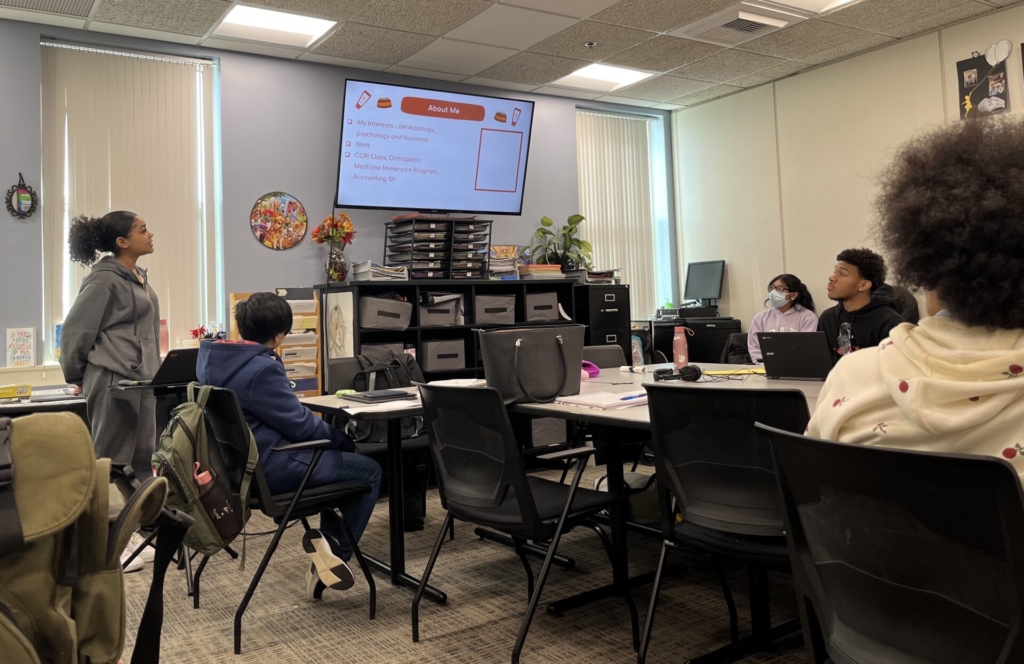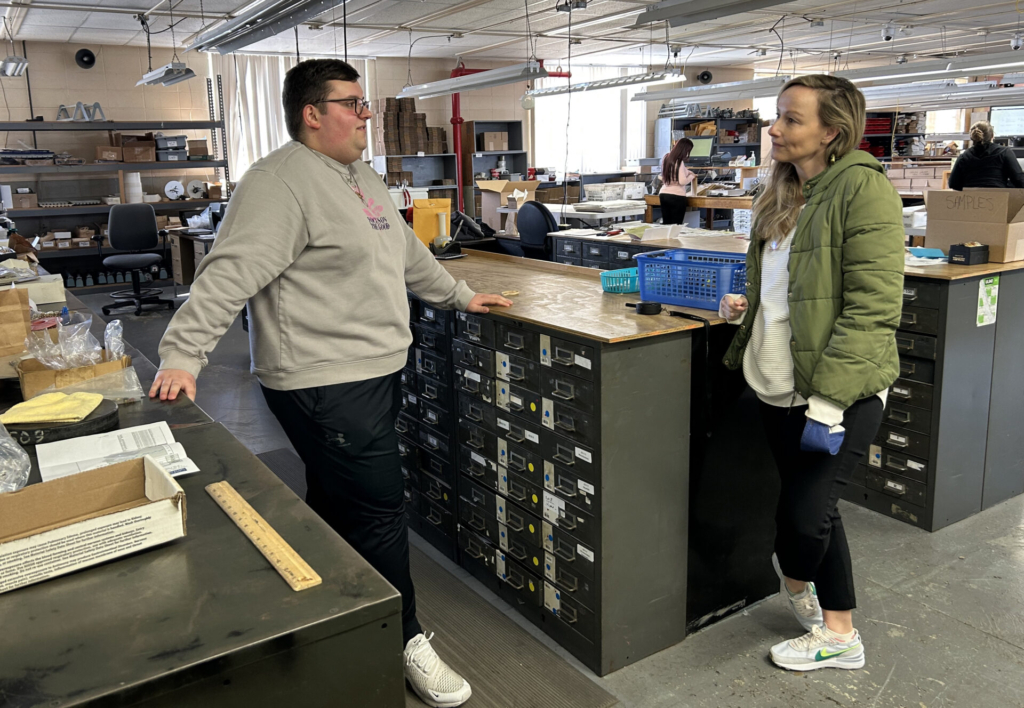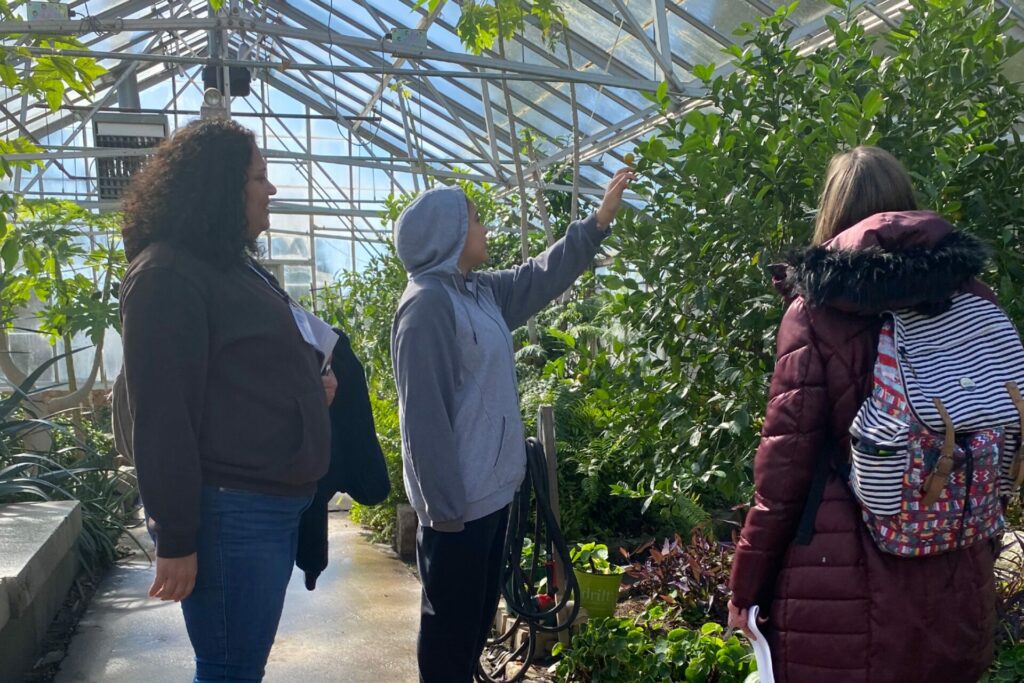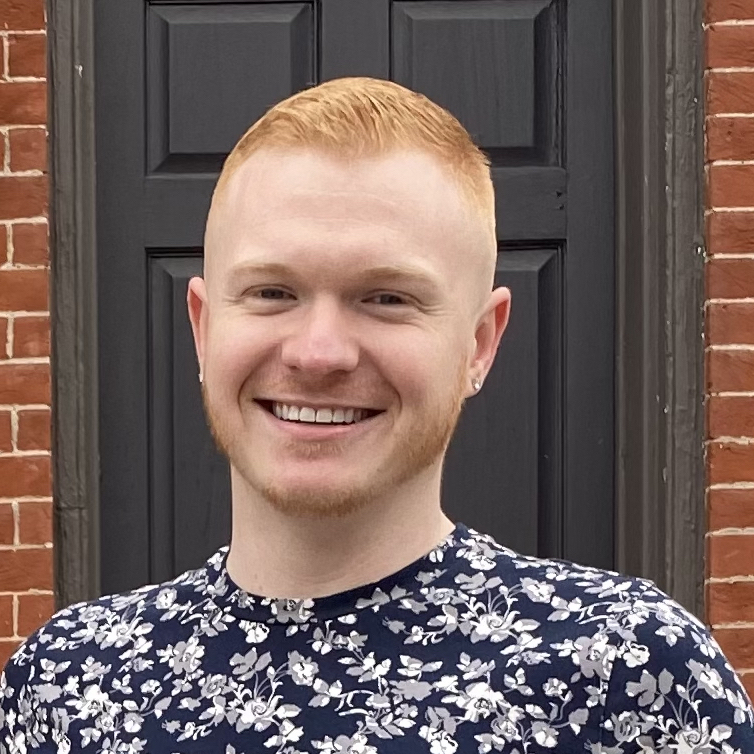There is a distinct way that the educators speak about their learners that allows relationships to thrive at the Met. The staff regard the learners as capable, trustworthy, and valuable.
Brianna Young, Consultant and Professor of Education
In early March, following a disruptive New England snowfall, a handful of Education Reimagined staff and Learning Lab community members—including participants from Open Connections, High School for the Recording Arts, WPS Institute, and more—made our way to the Met School in Providence, RI for a site visit. The purpose was to explore an example of learner-centered education in action and build relationships with fellow learner-centered leaders.
We can read about and discuss the power of learner-centered education, but there is really nothing like seeing how it transforms learners’ outlook on life first-hand. While it’s impossible to see all of the nuances of what makes the Met the beacon it is in just one day, through small group exploration, visits to off-campus internships, and end-of-day discussions, we left inspired by powerful practice, intrigued with new questions, and holding a deeper understanding of what makes the Met the Met.
A common theme prevailed: Joyful learners taking charge of their education, supported by caring and empowering adults.
The Met is a network of six small, public high schools located in Providence and Newport, RI, with four of the schools housed on the Met’s main campus. While they all live within the same system with shared resources and values, each school is fairly independent with their own principal, culture, and norms. The Met is also the flagship school of Big Picture Learning, an international network of learner-centered schools and programs, as well as the host of such initiatives as College Unbound and B-Unbound. After receiving an overview of the Met, we were sent off in small groups of two or three participants to explore one of the Met’s schools along with their learners and advisors. Throughout the visit, it was clear how the Met’s structure for their learners provided the framework to meaningfully learn from each experience and for the advisors to support all of their learners’ curiosities.

Learners meet with their advisory at the Met.
Meeting at the Met
I started my day at the Equality building. Upon entering, the environment was clearly different from any conventional school I’d been to. Round meeting tables filled the primary entry space where learners and advisors met in groups, ate lunch, hung out with friends, or worked independently. The walls were decorated with posters, billboards, and artwork created by learners. As I was there, one learner was putting up a collection of photos celebrating transformational women in history. Next to that was a bulletin board celebrating diversity—from LGBTQ+ to people of color. It was a space created by and for young people.
Smaller rooms surrounded this common area, and in these rooms, advisories were held. At the Met, advisory is a key structure for providing a stable, lasting community for young people to find belonging, chart their learning journey, and navigate through opportunities and challenges. An advisory is made up of a group of about 16 learners and one adult advisor. The group stays with the same advisor for all four years at the Met—learning, growing, and creating together. Advisories meet together multiple times per week, sometimes having full group conversations or in other instances, creating space for one-on-one meetings between advisor and learner to review and work on each learner’s individualized learning plans.
Each trimester, learners present a demonstration of learning that is aligned with their goals and plans—an opportunity to share what they’ve learned, projects they’ve built, or competencies they’ve developed. These demonstrations are a cornerstone component of the Big Picture Learning model and mark opportunities for young people to showcase and credential their learning. In the lead-up to these presentations, learners in the advisory help to review and provide constructive feedback on each other’s work.
Freshmen spend the most time in advisory as the young people grow together, work on learning plans, and create a resume to start finding their first internship—a staple structure at the Met. As they progress through the grade levels, learners spend less and less time in their advisory setting, although it continues to serve as an important anchor point for them. Instead, you might see learners more often off campus at their internship, taking classes at the adjacent community college, or working independently on a project. No matter the age, the advisories still meet to make personal connections, receive feedback, or go on outings—such as to a local bookstore.
Learning Out in the World
After meeting Equality’s principal, my host advisor Keith Nalbach, and a few learners, it was time to visit an internship. Yangtse Valdera, the learner we visited, was a senior and in her third year of an internship at the municipal courthouse. While she had originally wanted to go into healthcare, Yangtse realized it wasn’t the right path for her after exploring some details of the field. The courthouse provided a wealth of inspiration and numerous career paths that she was exploring.
Yangtse shared with us that at a past demonstration of learning, she created a mock crime scene at her school and walked her audience through each part of the investigation. Complete with fingerprints and other pieces of evidence, she highlighted the roles of each responding team, including first responders, investigators, and the coroner’s office. Wanting to be as detailed as possible, she designed the case to have ties to organized crime, elevating it to include FBI involvement.
To expand the personal relevance of this project, Yangtse created a rubric highlighting which characteristics of a career were most important to her. She then evaluated each job from the crime scene to help narrow down her desired career path. While an FBI investigator had been of interest, through her internship experience and learning demonstrations, she’s now exploring a career as a defense lawyer.
Throughout sharing internship successes, career aspirations, and important networking opportunities, the most powerful thing I heard Yangtse say was, “The Met is the best thing to happen to me.” Amidst caring for family members while still growing up and discovering the world, the Met offered Yangtse an opportunity to explore her interests, focus on her needs, and begin to create a future that is of her own making. And, Yangtse’s story is not an exception at the Met. Rather, it is the norm.
When speaking with colleagues later, each shared powerful stories of learners exploring their interests through internships and sometimes, creating their own businesses. One learner created a company to offer wellness products and yoga/meditation resources to people of color, who are often overlooked in the wellness market. (She’s currently in the process of selling the business to an investor who can help grow it, as she stays on in a creative capacity.)
From graphic design studios and bakeries to aquariums and libraries, the opportunities for internships and exploration are endless. For careers with stricter regulations, a small team at the Met develops technical programs for learners to gain experience in fields like construction or nursing. Some learners even graduate with a Certified Nursing Assistant certificate.
Back on campus, I had lunch with a group of advisors and other staff members. While their passion was clear, their dedication to each of their learners was even more evident. Advisors discussed internship wins, as well as specific learner interests for which they had difficulty finding opportunities. In real-time, I watched advisors share resources and even make a plan for a learner to join a visit to an artist’s studio on the upcoming Friday.
Amidst caring for family members while still growing up and discovering the world, the Met offered Yangtse an opportunity to explore her interests, focus on her needs, and begin to create a future that is of her own making.
Jason Krobatsch, Communications Manager, Education Reimagined

A learner shares insights from their internship at Air and Anchor jewelry store.
Debriefing the Experience
After about six hours of visiting and shadowing, we had the opportunity to debrief, first as a large group with a few members of the Met’s team, then again with only site visit participants. I was heartened to hear that my profoundly moving and inspiring experience was not unique to me; it was pervasive across all of the visitors, a testament to the Met’s campus and community.
My colleague Lindsy Ogawa noted how the responsibilities of and structures for advisors at the Met were so different from teachers in the conventional system. As teachers are facing increasing responsibilities and high burnout, the Met has attended to this slippery slope possibility with intention:
“Met educators do amazing, life-giving work. They, like most educators, work really hard—and know they are making the kind of difference they aspire to. You can feel it in how learners and adults talk about each other and how they grow and thrive together. But, what really strikes me is that educators here are not asked to do the impossible.
Rather, the Met School has built supportive conditions to enable both adults and young people to do work that matters to them. Everything is relational and contextualized, adapting to learners’ evolving interests, needs, and aspirations. Because these conditions are present, there isn’t a need for Met educators to constantly recreate the wheel or work against misaligned expectations.”
Brianna Young, a professor of education and consultant, took note of the ease and strength of communication between advisors and learners at the Met. From the four-year advisories to the individualized learning plans, the Met has designed a structure that both builds relationships and nurtures autonomy:
“There is a distinct way that the educators speak about their learners that allows relationships to thrive at the Met. The staff regard the learners as capable, trustworthy, and valuable. They release control to the creativity of their learners, guiding and supporting through thought-partnering, relevant lessons, and socially-embedded assessments that require relationships to be at the center in powerful ways.”
Alin Bennett, another Education Reimagined colleague, brought a unique lens to this site visit, having previously served as an advisor and principal at the Met:
“This visit enabled me to really look and listen for things from a place of wonder and curiosity. It allowed me to witness the Met’s work for what it is: a thriving learning community transforming the lives of young learners, families, and the adults supporting them. I took this opportunity to look beyond the functional and operational things going on. By making that ‘how’ a secondary matter in my thinking, I was able to live into the beauty of what was happening at the Met School.”
To Alin’s point, the Big Picture Learning’s “One Student at a Time” mantra is alive throughout the community, most evident in the individualized learning plan each learner develops along with their advisor in order to tie their interests to real-world learning and authentic assessment.
While the staff and advisors at the Met are enthusiastic yet modest, the Met boasts some impressive learner statistics. The Met sees a higher graduation rate compared to the Rhode Island average, as well as a higher diversity of learners. About 77% attend a four or two-year college, and others immediately enter the workforce with several years of internship experience. More than double the number of learners say they are interested in their classes at the Met compared to their counterparts in other public schools.
Eddie Fuentes, another Education Reimagined colleague who was participating in his first-ever site visit, perfectly summed up the power of seeing learner-centered education in person:
“Seeing the Met in action allowed me a glimpse into a future reality where learners are uniquely themselves, lead their own path to success, and seek to always better themselves and their communities. From the dedication and diligence of experienced, flexible advisors to the diverse and vast system of internships, the Met breathes as a living example of what is possible for the future of education and brings to life the theory of learner-centered education.”
Several hundred empowered learners are an incredible sight. But imagine if this kind of opportunity was possible for every child across the country. The possibilities for happiness, personal success, prepared young adults, and vibrant communities are endless if we invest in our young people and those who support them.

